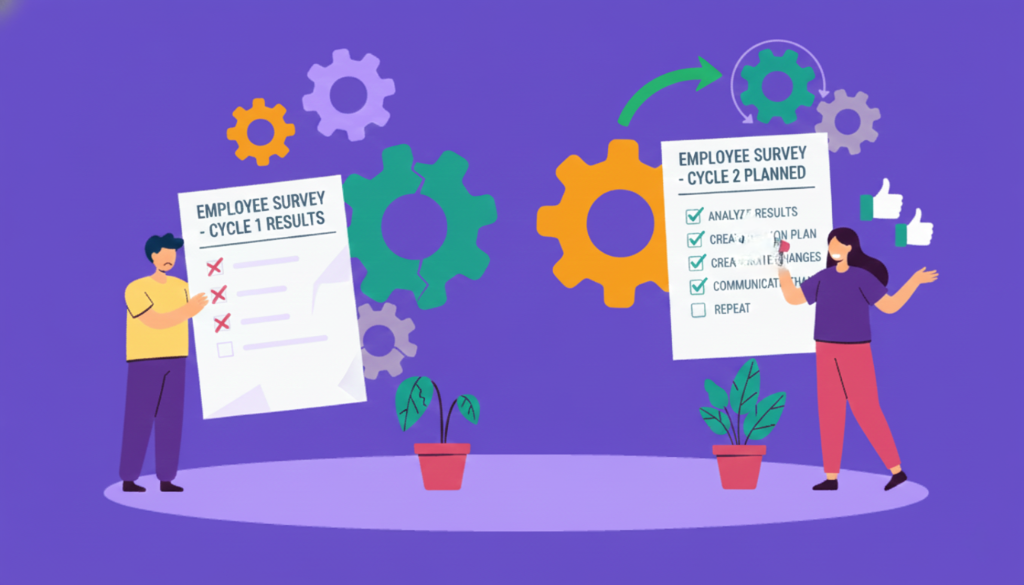Pulse Surveys: A Complete Guide to Real-Time Employee Insights

A Global Employee Recognition and Wellness Platform
Picture this, you run a big annual survey each December to check employee engagement and gather feedback. By the time you analyse results in January (and share them in March), the workplace might have changed drastically, new hires, new product launches, maybe even new leadership. Employees who had issues in December may feel even more frustrated by spring, especially if they’ve not had another venue to share concerns.
Pulse surveys solve this by letting you tap into employees’ real-time sentiment throughout the year, not just once. They’re quick to complete, easier to manage, and keep employees’ voices at the forefront, helping organizations become more people-centric and responsive.
Key Insights
- Concept of Pulse Surveys
- Importance of Pulse Surveys
- Best Practices When Creating a Pulse Surveys
- Practical Use Cases of Pulse Surveys
- Steps to Analyze Pulse Survey Data
What are Pulse Surveys You Ask?

The pulse survey is a regular, brief, and targeted questionnaire that tracks several metrics and characteristics of a job over time. These surveys are given to employees at regular intervals and typically consist of three to four standard questions.
In contrast to annual surveys that try to cram every aspect of the employee experience into one long questionnaire, pulse surveys are designed to be swift and actionable. Their frequent, targeted nature lets organizations respond to issues promptly, instead of waiting a whole year to make changes.
Annual surveys can still be useful for a broad, holistic view. But pulse surveys keep a constant finger on the organization’s emotional climate, letting you act before small issues blow up into major crises.
The work environment today demands that organizations do not rely solely on annual surveys; this can leave organizations reactive rather than proactive. Kantar states that "shorter surveys, especially those that can be completed in 10 minutes or less, yield higher response rates." This indicates a clear correlation between survey length and participation, with shorter surveys being more appealing to respondents.
To better illustrate the differences between survey types, I've created this comparative table:

Why Are Pulse Surveys Important? Here Are 8 Reasons.
Adopting Pulse Surveys can prove to be beneficial for several reasons:
-
Higher Participation Rates: According to a National Institutes of Health (NIH) publication, shorter surveys have significantly higher response rates because they demand less time from participants. That means if your employees can finish in 2-3 minutes, they’re far more likely to participate than if you hit them with 60 questions once a year. However, while shorter surveys are more appealing, over-surveying can lead to survey fatigue, so the organization needs to find a fine balance in the frequency of the surveys.
-
Timely Feedback: Let’s say your pulse survey reveals rising frustration with an internal promotion process. Instead of discovering that frustration in an annual survey 10 months later, this is crucial because The Workforce Institute found that 83% of employees feel they are not heard “fairly or equally,” and 60% believe their opinions are ignored. Responding swiftly shows employees that you’re not just gathering data for show.
In high-engagement business units, there is a 78% decrease in absenteeism, a 23% increase in profitability, a 10% increase in customer loyalty/engagement, and a 70% increase in well-being (thriving employees) compared to low-engagement business units Gallup State of the global workforce 2024
- Tracking Trends Over Time: Regular surveys provide a clear picture of engagement patterns, enabling proactive adjustments if required. Think of it like watching a line graph: you might measure the question “How likely are you to recommend this company to a friend?” monthly or quarterly to see how it evolves. If it dips sharply after a big policy change, you’ll know cause and effect more easily.

Pulse surveys and eNPS (Employee Net Promoter Score) often go hand in hand, letting you see if employees become more or less “promoters” of your organization as the months roll on.
- Setting Industry Benchmarks: Surveys are an excellent way to set industry benchmarks for your company or even across your sector. Because pulse surveys often focus on consistent, standardized questions (like “I have the tools I need to succeed”), you can gather data to compare your employee engagement levels to broader norms. Over time, you build a more accurate and objective picture of how your workforce stands relative to similar organizations, without having to wait for an official annual study.
This helps you see if you’re lagging behind, typical engagement in your industry or if you’re leading the pack, shaping your people strategy accordingly.
-
Linking to Key Metrics: HBR’s research has long shown that more engaged employees produce better customer experiences. By using pulse surveys to gauge engagement or eNPS and comparing that to your CSAT or product satisfaction data, you can draw correlations. When eNPS jumps, does your CSAT also climb?
-
Enhancing Remote Work: With remote or hybrid setups, it’s easy for employees to feel isolated or unclear about goals. Quick monthly pulses can ask, “Are you getting enough support from your manager?” or “Do you feel connected to team updates?” If the data shows a slump in certain remote teams, you can intervene with improved communication tools or more frequent manager check-ins.
-
Fostering Inclusivity: If your last annual survey revealed a sense of exclusion among certain groups, you can’t wait a whole year to see if your actions are paying off. Pulse surveys let you measure progress more frequently. For example, a monthly or quarterly item like “I feel respected by my colleagues” helps you know if your DEIB programs are actually making a dent.
-
Building Trust: Building trust demands consistent effort and transparent follow-through. Frequent pulses, paired with clear and honest updates such as saying, “You mentioned feeling undervalued, so here’s what we’re doing about it” send a strong signal of respect and care. As Lincoln Chafee wisely stated,“Trust is built with consistency.” It’s not merely the act of asking for feedback that fosters trust but the regular demonstration that the organization cares enough to listen and respond meaningfully.
How to Create an Effective Pulse Survey
Creating pulse surveys that get honest feedback from your staff and drive real change isn't difficult, but it does need careful planning. Here's how you can make your surveys work:
1. Short, Focused, and Repetitive

Source: Vantage Pulse
A pulse survey should be short enough to respect employees’ time but focused enough to yield meaningful insights. Typically, that means 5-15 questions total. Here’s the rationale behind it and how to apply it:
a. Core Questions (2–3 items repeated each time):
-
These are your “trend trackers” – stable metrics you want to monitor month over month or quarter over quarter (for instance, eNPS or “I understand my role in the company’s success”).
-
By repeating them consistently, you create a baseline that’s easy to compare over time. If your “I feel valued at work” score was 80% last pulse but dips to 70% this time, you know something changed.
b. Rotating Questions (2–5 items on current priorities):
-
The beauty of pulse surveys is you can adapt them to what’s relevant right now. Are you rolling out new software? Ask “I feel comfortable using the new platform.” Did you start a mentorship program? Ask “My mentorship sessions are contributing to my professional growth.”
-
This keeps your survey timely and prevents it from feeling stale. Employees see that you’re focusing on real, pressing concerns rather than generic or outdated questions.
Don’t drastically change your entire survey each time. Keep at least a couple of consistent items so you can watch real trends but stay flexible for any pressing topics.
2. The 70:20:10 Rule
This rule helps you structure your questions so they’re both actionable and informative:
a. 70% Driver or Actionable Items
-
Example drivers: “My manager supports my professional growth,” “I have the resources to do my job,” “I receive recognition for good work.”
-
Why it matters: These statements directly point to what you can fix (manager training, resource allocation, etc.). If responses dip, you know exactly where to intervene.
b. 20% Outcome Questions
-
Typically, these measure overall engagement or satisfaction. Examples: “I would recommend this company to a friend” (eNPS) or “I’m proud to work here.”
-
Why it matters: Outcomes gauge the big picture. They tell you if your drivers are collectively pushing the needle up or down in employee morale and loyalty.
c. 10% Open-Ended
-
This might be a question like: “What’s one thing we could do to better support you right now?” or “Any additional comments you’d like to share about the new policy?”
-
Why it matters: Rating scales can’t capture everything. Open text gives employees a space for nuance, suggestions, or flagged concerns you’d never anticipate.
3. Ensuring Anonymity and Encourage Openness
One of the biggest reasons employees hold back on surveys is fear of repercussions especially with sensitive topics. Here’s how to tackle that:
a. Anonymity vs. Confidentiality
- Anonymity: Responses can’t be traced back to an individual at all.
A study published in the Journal of General Internal Medicine found that response rates for anonymous surveys ranged from 56% to 63.3%, significantly outperforming the response rates for non-anonymous methods.
- Confidentiality: Some system or admin might see raw data, but results are reported in aggregated form (with no personal identifiers).
Recommended Read: 12 Tips On How To Conduct An Anonymous Employee Survey In 2025
Which to choose? For highly sensitive topics, true anonymity can yield more honest answers. But if you need to track data by department or role, you might use confidentiality, ensuring that only an aggregated group’s feedback is shared.
b. Communicating Privacy Measures
-
Before sending out the survey, clarify how you’ll use the data and who will see individual responses. If it’s run through a third-party platform, let employees know that, too.
-
Emphasize that you’ll only report aggregated themes (like “70% of our engineering team felt positive about remote scheduling”).
c. Overcoming the Challenge of Trust
-
Even if you label a survey “anonymous,” employees won’t automatically trust it. You earn trust by consistently sharing results in a group format, never singling out individuals, and taking visible action on the insights.
-
Each pulse cycle done right must reinforce that people can speak freely. Over time, candor increases, and you get more authentic data.
d. Examples of Encouraging Openness
-
“We genuinely want your unfiltered feedback so we can make improvements that matter to you.”
-
“We don’t track who said what. Our reporting only shows department-level summaries.”
-
“After the last pulse survey, we added extra resources for Team A, which had flagged burnout. Now we want to see if that helped. Let us know!”
With these fundamentals in place, let’s look at how pulse surveys apply in real-world scenarios
Practical Use Cases for Pulse Surveys
Post-Training or Change Management
Organizations often roll out new software or launch major training programs. A pulse survey a couple of weeks later can reveal if people are confused, content, or needing more help. By quickly measuring adaptation, you can adjust resources or hold refresher sessions before frustration grows. This proactive approach keeps morale high and ensures your investment in change truly pays off.
Action Plan Follow-Ups
Your annual survey may have revealed a call for better career paths, leading you to create mentorship programs or training tracks. Short monthly pulses can confirm if employees feel more supported or if they still lack clarity. This keeps you agile: if feedback is lukewarm, pivot your efforts to better match what employees need. By consistently following up, you maintain trust and show that you truly value employee input.
Remote or Hybrid Team Morale

Distributed workforces can feel disconnected, especially if policies or communication styles don’t reach everyone equally. Short pulses capture whether remote workers are updated on company news, recognized for achievements, and included in decision-making. These insights stop problems like isolation or burnout from festering. When data suggests remote staff feel left out, you can respond with timely improvements in communication or collaboration tools.
Safety Pulse Surveys
For settings like factories, warehouses, healthcare sites, or construction zones, safety pulses offer a quick gauge of potential hazards or training gaps. Employees might report missing protective gear or confusing procedures. By dealing with these issues early, you can reduce incidents and build a culture of safety. Frequent pulses also encourage employees to speak up without fear, reminding them that their well-being is a top priority.
Measuring and Acting on Pulse Survey Data
Key Metrics to Track
You can’t act effectively without knowing what to measure. Three vital metrics include:
-
Participation Rates: A consistently high rate means employees trust the process and find it relevant. If rates start dropping, it’s a red flag that your pulses may be too long, too frequent, or not resulting in visible change.
-
Sentiment Analysis: Go beyond raw scores by analyzing open-ended responses for positive, neutral, or negative themes. Text-mining tools or manual categorization both works, but the goal remains the same: to understand underlying feelings or sentiment of employees not just surface-level numbers.
-
Engagement Scores: eNPS or an overall engagement rating helps you see how employees feel about the company at a macro level. Repeat these items each pulse, so you can track engagement trends month-over-month or quarter-over-quarter.
Discover how Vantage Pulse empowers you to track participation, analyze sentiment, and boost engagement effortlessly.
Steps for Analyzing Data
Data alone doesn’t solve problems, analysis and action do.
- Spot Trends: Look at changes in repeated questions (like “Do you have the resources to do your job?”). If scores dip after a new policy, you have an immediate correlation to explore.

Source: Vantage Pulse
-
Identify Issues: Zero in on low-scoring items or recurring negative themes in open comments. These pinpoint exactly where you need to invest time or resources.
-
Prioritize Actions: Every pulse might unveil multiple concerns. Tackle the most critical or most fixable issues first. Quick wins build morale and demonstrate that feedback leads to real outcomes
Visualizing Results Using Dashboards
Data visualization helps stakeholders grasp the story in seconds rather than wading through spreadsheets. You might use:
-
Color-Coded Heatmaps: Quickly reveal which teams or departments are struggling.

Source: Vantage Pulse -
Line Charts for Trends: Show how an eNPS score evolves pulse to pulse, highlighting major dips or spikes.
-
Word Clouds (for open texts): Emphasize frequently mentioned terms, so you know what’s on employees’ minds.
Highlighting Transparency
It’s not enough just to gather data; how you share it with employees is equally crucial:
-
Summarize the main insights at a high level (e.g., “80% feel aligned with our new goals, 20% want more manager support”).
-
Acknowledge Concerns: If there’s a worrying trend, be open. Employees respect honesty, and acknowledging problems fosters trust.
-
Communicate Next Steps: Share what you plan to do in response to the feedback. This loop “survey → share results → take action → follow up” keeps people engaged.
Discussing Benchmarking Against Industry Standards
Pulse surveys don’t just offer internal comparisons over time. They also let you see if you’re on par with external benchmarks:
-
Why Benchmark?: Knowing how your engagement or sentiment scores stack up against an industry baseline can guide realistic goals. It also helps leadership understand if improvements are genuinely competitive or just “good enough” internally.
-
Where to Find Benchmarks: Look to credible HR research bodies (like the CIPD, Gallup, or SHRM). But remember, external data is best used as a reference point, not a be-all and end-all.
-
Balancing Internal vs. External: Your internal trend lines (i.e., “Are we improving from our last pulse?”) remain the most important measure of success. External benchmarks matter, but each organization has its own unique culture and starting point.
Conclusion
At the end of the day, pulse surveys aren’t just another HR tool – they’re a way to ensure every voice in your organization is heard, respected, and responded to in real time. Instead of waiting twelve long months for feedback that might already be outdated, you’re constantly staying in tune with how people feel right now. That genuine, continuous dialogue is what truly helps a workplace become thriving and responsive.
If you’re looking for a simpler way to manage these frequent surveys, so you can focus on acting rather than on admin, a platform like Vantage Pulse can help handle the logistics. But remember: your organization is where real change happens. It’s your openness to listening, your willingness to follow up on what you learn, and your commitment to a people-centric culture that makes all the differen
FAQs
Q. Are pulse surveys only meant for employees, or should managers participate too?
Everyone can benefit from a pulse survey, even managers. Having them share their perspectives provides a more rounded view of the workplace pulse, helping identify issues that may not surface otherwise.
Q. What if we want to cover sensitive topics like mental health in a pulse survey?
Yes, you can include questions on well-being or stress, provided you ensure anonymity or confidentiality. Keep them concise and handle results with care, offering resources or support if concerns arise.
Q. Can pulse survey data ever get misinterpreted or skewed?
It’s possible if questions aren’t clear or if results are viewed in isolation. To avoid this, maintain consistent question wording, look at trends over time, and compare data points (like engagement vs. turnover) for a fuller picture.



















